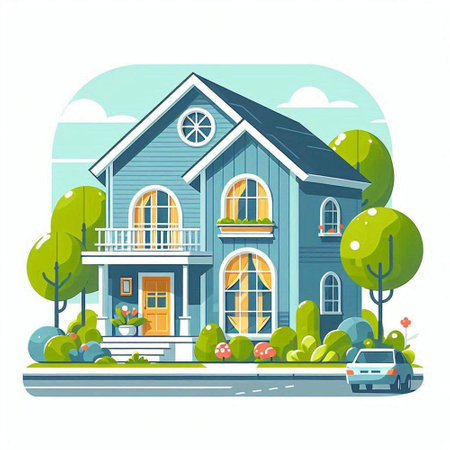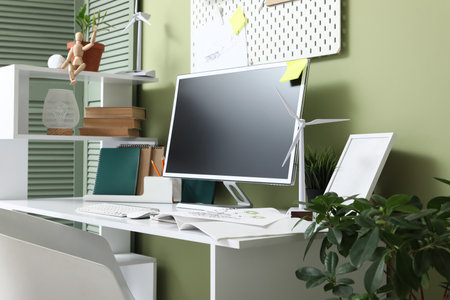1. Understanding Feng Shui and Its Relevance in the US
Feng Shui, which translates to “wind and water,” is an ancient Chinese practice focused on creating harmony between people and their environment. At its core, Feng Shui is about arranging spaces in a way that promotes positive energy, productivity, and overall well-being. While this tradition has deep roots in Chinese culture, its principles have found a new home in modern American interior design—especially when it comes to creating effective home offices.
In the United States, more people are working from home than ever before. As a result, homeowners are searching for ways to make their workspaces not only functional but also comfortable and inspiring. This is where Feng Shui comes in: its timeless ideas can help transform any room into a space that supports focus, creativity, and balance. American homeowners appreciate Feng Shui because it offers easy-to-follow guidelines that can be adapted to suit different tastes and lifestyles.
Why Feng Shui Matters in the Modern Home Office
The main goal of Feng Shui in a home office is to create an environment that boosts energy flow (also known as “chi”) and minimizes distractions. By choosing the right colors, arranging furniture thoughtfully, and incorporating natural elements, you can turn any corner or spare room into a productive workspace that feels good to be in. The trend toward personalizing work-from-home setups has made Feng Shui even more relevant across the US.
Key Principles of Feng Shui for Home Offices
| Principle | Description | Modern Application |
|---|---|---|
| Balance | Create harmony by balancing colors, shapes, and materials. | Mix soothing tones with energizing accents for a dynamic workspace. |
| Energy Flow (Chi) | Arrange furniture and decor to allow free movement of energy. | Avoid clutter; place your desk where you can see the door. |
| Natural Elements | Use elements like wood, metal, water, earth, and fire for balance. | Add plants, natural light, or water features for freshness and calm. |
The Growing Popularity of Feng Shui Among Americans
With a greater emphasis on wellness and work-life balance, more Americans are turning to Feng Shui as a tool for enhancing productivity at home. Social media trends and popular design shows have spotlighted how simple changes—like using certain colors or rearranging your desk—can make a noticeable difference. Whether you’re new to Feng Shui or just looking for fresh inspiration for your home office, understanding its basic principles is the first step toward designing a space that works best for you in the US context.
2. The Psychology of Color in the American Workplace
When it comes to designing a modern home office in the United States, understanding how color impacts mood and productivity is key. Many Americans are now working from home, blending comfort with efficiency, so choosing the right colors is more important than ever.
How Colors Affect Mood and Productivity
Studies in American business culture show that color can influence everything from focus to creativity. For example, research from the University of Texas found that bland office colors like gray and beige could increase feelings of sadness or depression, especially among women. Meanwhile, brighter tones such as blue or green are linked to higher productivity and happiness for both men and women. Tech companies like Google and Facebook have famously used vibrant color schemes in their offices to boost energy and innovation—a trend that has carried over into home workspaces.
Popular Feng Shui Colors and Their Effects
| Color | Feng Shui Meaning | Common US Associations | Impact on Work-from-Home Productivity |
|---|---|---|---|
| Blue | Calm, focus, clarity | Trust, professionalism | Reduces stress, increases concentration—ideal for analytical tasks |
| Green | Growth, balance, renewal | Nature, freshness | Promotes calmness and well-being—great for long work hours |
| Yellow | Optimism, energy, warmth | Creativity, friendliness | Lifts mood, encourages creativity—best as an accent color |
| White | Simplicity, purity | Cleanliness, openness | Makes spaces feel larger and brighter—can be paired with bold accents for balance |
| Gray | Sophistication, neutrality | Modernity, professionalism | A good base color but may need colorful accents to avoid dullness or fatigue |
| Red (as an accent) | Energy, passion | Courage, excitement | Sparks motivation but can be overwhelming if overused—best for small touches like décor or artwork |
The Rise of Personalized Home Office Palettes in America
The work-from-home movement has encouraged Americans to personalize their home offices more than ever. While traditional Feng Shui principles suggest certain colors for specific energies, many people in the US are blending these ideas with personal taste and popular design trends. Ultimately, choosing colors that make you feel motivated and comfortable will help you create a balanced and productive workspace tailored to your unique needs.

3. Top Feng Shui Colors for Modern US Home Offices
Choosing the right colors for your home office can make a big difference in how you feel and work every day. According to Feng Shui, some colors can boost focus, creativity, and calmness—all things we want in a productive workspace. Here are the top Feng Shui-approved colors that also match today’s American home office styles.
Blues: Calm and Clarity
Blue is a go-to color for many modern offices. In Feng Shui, blue represents calm energy and clear communication. Lighter blues are great for creating a peaceful vibe, while deeper navy shades add sophistication without feeling too bold. Blue works especially well if your job involves lots of thinking or talking with others.
Best Ways to Use Blue:
- Pale blue walls for a soothing background
- Navy accent chairs or shelving
- Sky-blue artwork or decor pieces
Greens: Balance and Freshness
Green brings the feeling of growth and renewal into your office space. It’s perfect for those who want to stay balanced and energized throughout the workday. From soft sage to rich emerald, green fits easily into both traditional and contemporary American decor.
Best Ways to Use Green:
- Sage green rugs or curtains
- Potted plants (real or high-quality faux)
- Moss-green desk accessories
Earth Tones: Stability and Comfort
Earth tones—like beige, taupe, terracotta, and warm browns—ground your workspace and create a sense of stability. These colors help you feel centered, which is great for staying focused during busy days.
Best Ways to Use Earth Tones:
- Terracotta planters or pottery
- Warm tan desks or storage bins
- Coffee-colored throw pillows or blankets on your chair
Neutrals: Flexibility and Lightness
Neutrals such as white, light gray, and soft cream are always in style in the US. They keep your office looking clean, bright, and open—plus they pair well with any accent color you like.
Best Ways to Use Neutrals:
- Crisp white walls for a fresh start
- Light gray desks or shelves for a modern touch
- Creamy area rugs to soften hardwood floors
Quick Guide: Feng Shui Colors & Their Benefits for US Home Offices
| Color | Feng Shui Benefit | Modern US Office Style Tip |
|---|---|---|
| Blue | Calm, communication, focus | Pale blue walls or navy accents; pairs well with wood & metal furniture |
| Green | Balance, renewal, vitality | Add plants or sage green textiles; matches natural woods & black metal frames |
| Earth Tones | Stability, grounding, comfort | Taupe or terracotta decor; works with both rustic and modern looks |
| Neutrals (White/Gray/Cream) | Openness, clarity, flexibility | Create a bright base; mix with pops of color through art or accessories |
Selecting any of these colors—or mixing a few—can help you create an office that feels good and looks great in any American home.
4. Choosing the Right Color for Your Home Office Vibe
Picking the best Feng Shui colors for your modern home office in the US is all about balancing your work goals, office layout, and personal style. Whether you’re working from a cozy apartment nook or a dedicated office room, the right color can boost focus, creativity, and comfort. Here’s how to make your space work for you:
Consider Your Work Goals
Think about what you want to achieve in your home office. Are you aiming for productivity, creativity, calmness, or maybe better communication? Each goal connects with different Feng Shui colors:
| Work Goal | Recommended Colors | Why It Works |
|---|---|---|
| Productivity & Focus | Soft blues, greens | Calming and help with concentration |
| Creativity & Innovation | Pale yellow, orange accents | Stimulate fresh ideas and positivity |
| Calm & Stress Reduction | Earthy tones (beige, taupe), light gray | Create a grounded and peaceful vibe |
| Communication & Networking | White, light blue, pale green | Encourage open thinking and connection |
Match Colors to Your Office Layout
The way your workspace is set up can influence which colors will feel harmonious. For example:
- If your office faces north (less sunlight), add warm tones like soft yellow or beige to brighten the mood.
- If it gets plenty of sunlight, balance strong natural light with cool shades like blue or green.
- Tiny spaces benefit from lighter hues that make rooms feel bigger—think white or pale pastels.
- Larger offices can handle deeper tones like navy or forest green without feeling overwhelming.
Blend With Your Personal Style
Your home office should reflect your personality! Feng Shui encourages harmony but doesn’t mean you have to give up your favorite looks. For a modern American home office:
- Add pops of color through desk accessories, wall art, or even your chair—these are easy to switch out if you want a seasonal refresh.
- If you love minimalism, stick with whites and grays but use plants or wood accents for warmth.
- If you’re into bold design, pick one main color for an accent wall and keep everything else neutral.
Selecting Colors Based on Work Type
| Type of Work | Suggested Colors |
|---|---|
| Creative Professions (designers, writers) | Pale yellow, orange accents, light blue for inspiration |
| Finance & Analysis (accountants, planners) | Navy blue, forest green for stability and focus |
| Counseling & Communication (coaches, therapists) | Pale green, soft white to encourage trust and calmness |
| Tech & IT (developers, engineers) | Crisp white with blue or gray touches for clarity and precision |
Quick Tips to Get Started:
- Test paint samples before committing—light changes everything!
- Add color through décor if painting isn’t an option.
- Avoid overly bright reds or dark blacks as main colors—they can be too intense for most home offices.
- Balance is key: mix neutrals with color pops that fit your vibe.
- Potted plants bring in natural green energy and work well with any style.
5. Integrating Feng Shui Colors with American Decor Trends
Blending traditional Feng Shui color principles with popular American interior design styles can create a home office that feels both balanced and uniquely yours. Here’s how to harmonize energy flow while staying true to your favorite US decor themes.
Feng Shui Color Basics
Feng Shui recommends specific colors based on the five elements: Wood (green, brown), Fire (red, orange, strong yellow), Earth (beige, light yellow, sandy tones), Metal (white, gray, metallics), and Water (blue, black). These can be adapted to fit different American home office styles.
Popular US Decor Styles and How to Blend Feng Shui Colors
| Style | Main Features | Feng Shui Colors That Fit | Tips for Integration |
|---|---|---|---|
| Coastal | Light woods, whites, blues, relaxed vibe | Water element colors: blue, soft green; white for metal balance | Add blue accent walls or décor; use white desks or bookshelves; bring in soft green plants |
| Modern Farmhouse | Neutrals, natural textures, rustic touches | Earth tones: beige, tan; wood element: green accents; some black (water) | Choose beige or tan wall paint; display wooden shelves; add greenery in ceramic pots |
| Industrial | Grays, metals, exposed brick, urban edge | Metal element: gray, white; hints of red/orange (fire) for energy | Use gray desks or chairs; incorporate metallic frames; add a red lamp or art piece for warmth |
| Mid-Century Modern | Crisp lines, bold accent colors, organic shapes | Wood and fire: green, orange, yellow accents; white for clarity | Select mid-century furniture in green or yellow upholstery; hang abstract art with orange pops |
| Bohemian (Boho) | Layered textiles, eclectic patterns, vibrant colors | Diverse: mix of all five elements—blues, greens, reds, earth tones | Add colorful cushions and rugs; use plants for wood element; include a variety of textures and hues for balance |
Tips for Harmony and Self-Expression
- Start Small: Use accessories like pillows or desk organizers to introduce Feng Shui colors before repainting walls.
- Mood Matching: Choose colors based on the energy you want—blue for calm focus (water), green for growth and creativity (wood), red or orange for motivation (fire).
- Your Unique Spin: Combine traditional Feng Shui recommendations with your favorite American style pieces—don’t be afraid to mix metals with woods or cool tones with warm accents.
Your Modern Feng Shui Office Awaits!
Create a workspace that’s both supportive and stylish by thoughtfully blending these color choices with decor trends you love. The result? A balanced environment where positive energy flows—and you feel right at home.


